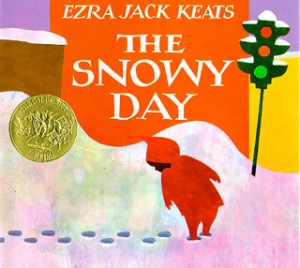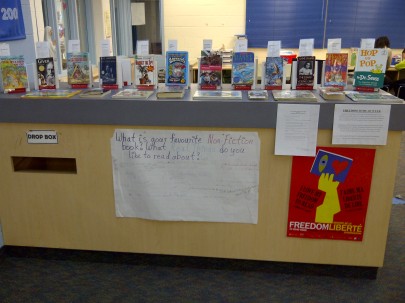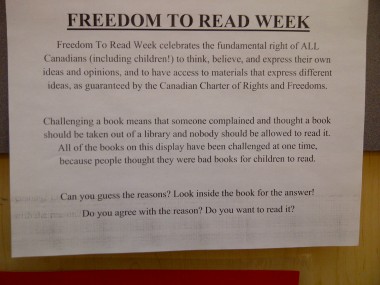 Freedom to Read Week in Canada was February 22-28 this year, so this post is a little bit late, but I still wanted to write about it.
Freedom to Read Week in Canada was February 22-28 this year, so this post is a little bit late, but I still wanted to write about it.
At my school this last year, I had a high counter right beside the main door that I used for a book display, which I changed weekly. I used different themes, genres, holidays, and once a month I asked a grade to pick out their favourite books for the display. I tried to combine fiction and nonfiction and different reading levels so there was usually something for everyone, and I’d often select the books I read to the younger grades for storytime from that week’s display, unless the teacher had made a special request. For Freedom to Read Week, I wanted to display challenged books but to also give some of the reasons they were challenged and encourage the students to think about not just why were they challenged, but why were they defended, and did they, the students, agree with either side?
I put up a Freedom to Read poster that I got from the OLA Super Conference and added two sheets above outlining what Freedom to Read Week was about and a copy of the Ontario Library Association Position on Children’s Rights in the Library.
The sign above says:
FREEDOM TO READ WEEK
Freedom To Read Week celebrates the fundamental right of ALL Canadians (including children!) to think, believe, and express their own ideas and opinions, and to have access to materials that express different ideas, as guaranteed by the Canadian Charter of Rights and Freedoms.
Challenging a book means that someone complained and thought a book should be taken out of a library and nobody should be allowed to read it. All of the books on this display have been challenged at one time, because people thought they were bad books for children to read.
Can you guess the reasons? Look inside the book for the answer!
Do you agree with the reason? Do you want to read it?
I searched for lists of commonly challenged books online and the arguments both for and against them, and then I searched the school library to see what books we owned. I made a large bookmark for each book I selected for the display with the title, author, original publication date, arguments for and against each book, the source I’d found the information from, and ended each one by asking “What do you think?” You can somewhat see the bookmarks sticking up from the books in the display photo above.
The books I selected were:
- The Harry Potter series by J.K. Rowling
- The Wizard of OZ by L. Frank Baum
- Anne Frank: The Diary of a Young Girl by Anne Frank
- Harriet the Spy by Louise Fitzhugh
- The Captain Underpants series by Dav Pilkey
- The Giver by Lois Lowry
- The Adventures of Huckleberry Finn by Mark Twain
- The Outsiders by S.E. Hinton
- Thomas Snowsuit by Robert Munsch
- Hop on Pop by Dr. Seuss
- Alice’s Adventures in Wonderland by Lewis Carroll
- Walter the Farting Dog by William Kotzwinkle and Glenn Murray
- Where the Wild Things Are by Maurice Sendak
- Strega Nona by Tomie dePaola
- Little Women by Louisa May Alcott
- The Hunger Games series by Suzanne Collins
- The Sissy Duckling by Harvey Fierstein
- The Chronicles of Narnia series by C.S. Lewis
- Charlie and the Chocolate Factory by Road Dahl
- Three Wishes: Palestinian and Israeli Children Speak by Deborah Ellis
- A Wrinkle in Time by Madeleine L’Engle
 Another challenged book that I read during storytime that week was The Snowy Day by Ezra Jack Keats, published in 1962 and awarded the Caldecott Medal in 1963 among controversy. The story is about a little boy who wanders around his neighbourhood exploring after a snowfall. I read it to 2 classes, around 35-ish kids or so (I usually let the kids vote between 2 books for storytime, and the other classes wanted to hear Where the Wild Things Are), and at the end I asked them why they thought some people would not like the book and think that it shouldn’t be in libraries and at children shouldn’t be allowed to read it. The kids suggested all kinds of things from the story, how Peter didn’t tell his mother where he was going and went out without a grown-up and shouldn’t have knocked down snow with a stick and shouldn’t have thrown snowballs with the bigger kids and shouldn’t have tracked snow inside and a lot of reasons that probably say a lot about our helicopter parenting society, but not one of them guessed the real reason, nor did some of the older students who tried to guess what was wrong with it. Every adult I asked looked at the cover and knew right away.
Another challenged book that I read during storytime that week was The Snowy Day by Ezra Jack Keats, published in 1962 and awarded the Caldecott Medal in 1963 among controversy. The story is about a little boy who wanders around his neighbourhood exploring after a snowfall. I read it to 2 classes, around 35-ish kids or so (I usually let the kids vote between 2 books for storytime, and the other classes wanted to hear Where the Wild Things Are), and at the end I asked them why they thought some people would not like the book and think that it shouldn’t be in libraries and at children shouldn’t be allowed to read it. The kids suggested all kinds of things from the story, how Peter didn’t tell his mother where he was going and went out without a grown-up and shouldn’t have knocked down snow with a stick and shouldn’t have thrown snowballs with the bigger kids and shouldn’t have tracked snow inside and a lot of reasons that probably say a lot about our helicopter parenting society, but not one of them guessed the real reason, nor did some of the older students who tried to guess what was wrong with it. Every adult I asked looked at the cover and knew right away.
The Snowy Day was the first full-colour picture book with an African-American protagonist. All of the kids, regardless of race, thought this was a bizarre reason to object to the book. It gave me an excellent opportunity to point out how attitudes change over time, and what some people find objectionable others have no problem with or want to promote, and all of those people use the library and deserve to have books.
You can find the bookmarks I made here: Reasons for challenged books .


